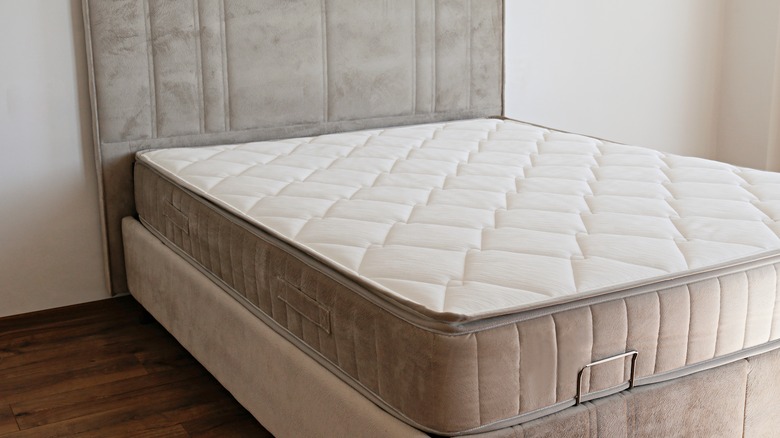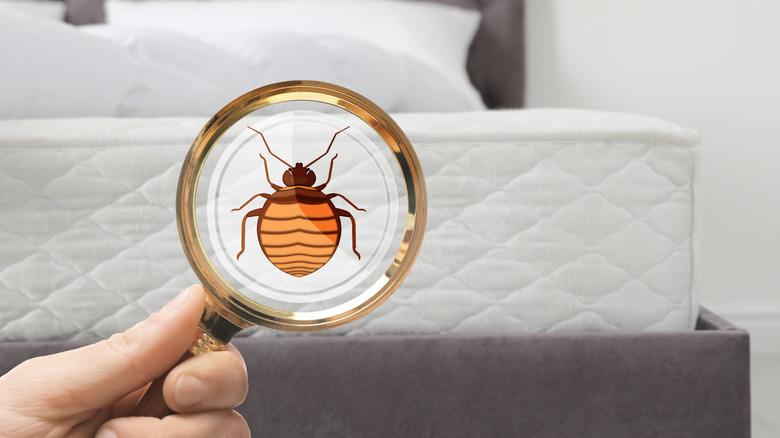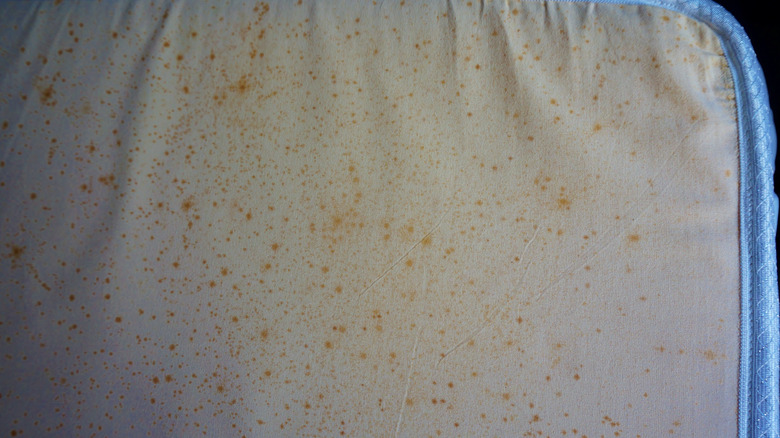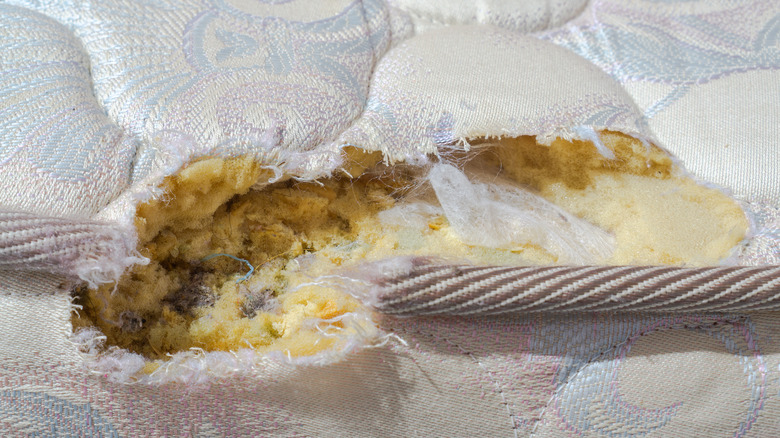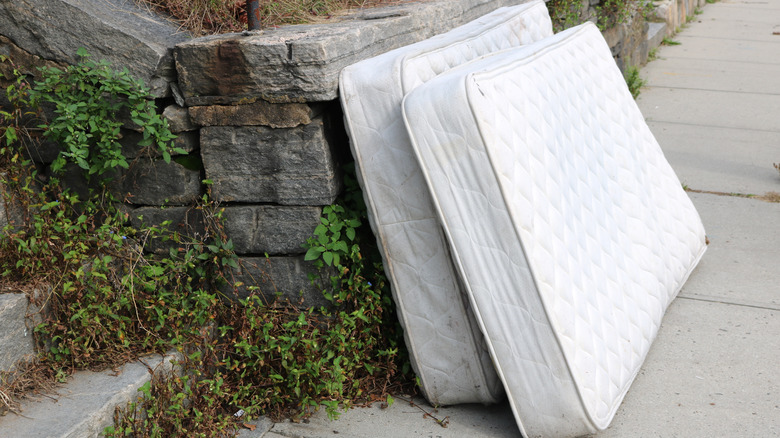Here Are The Signs Your Mattress Is Too Old
Many people make the mistake of treating mattresses like fine china or family heirlooms. Here's the thing: this is perfectly normal. The bed is a happy place that most people visit every day, and it's easy to mix up feelings of comfort with familiarity. Plus, the average person is unlikely to fix something that isn't broken. There are a number of negative side effects that come with sleeping on a passed-its-shelf life mattress, including health issues.
But how old is too old, you might wonder. Well, the Sleep Foundation Organization states that most mattresses might need to be changed when they hit the 7 to 10-year mark, but lower-quality options could wear out even sooner. If your mattress is more familiar than comfortable, you might just need a new one. Do you think you fall into this category? Here are some signs that indicate that your mattress is too old.
Your bed has pests
You might think that the absence of bed bug bites on your skin means that your mattress is pest-free, but this isn't always the case. LawnStarter states that an old mattress might house up to eight other bed pests. Some of the most common are fleas, German cockroach nymphs, bat bugs, and carpet beetles. These pests are sneaky and may get to your mattress by catching a ride from your pet, old bedding, carpets, or even your attics or chimneys, per Pest Off. Sadly, it's almost impossible to get rid of bed pests without using chemicals or heavy labor, especially if these pests have been residents of your mattress for a while.
This is because many mattress pests are notorious for spending their lifetime weaving their eggs into fabrics, via ABC Home & Commercial Services. If you have bed pests, they might linger around and attach to any new mattresses you may purchase or even get into neighboring rooms and apartments. You might wonder why chemical treatments aren't enough to eliminate mattress pests. Sleeping Organic says chemical treatments might be dangerous, mainly if used directly on the mattress or bedding. Once you sleep, you inhale the used pesticides, which could cause various problems, including respiratory difficulties. So, if your mattress has been around for a while and houses mattress pests, you should get another.
Your allergies are getting worse
As your mattress ages, it steadily builds up a collection of dust, mold, pet fur, mildew, and other allergens. And unlike your sheets that can be cleaned easily, you cannot exactly soak your mattress to clean it. Consequently, you can only prevent the build-up of these allergens in some parts of your mattress. Since allergens are too tiny to see, people hardly notice their presence under normal conditions. This is a problem because you can inhale these allergens while you sleep. If you're constantly waking up with a runny nose, itchy eyes, and even skin irritation, your mattress might be to blame.
You might think allergic reactions are limited to small symptoms such as a runny nose, but here's the scary part: Dust mite allergies can also cause asthma, per Mayo Clinic. An annual Asthma + Lung UK survey showed that dust mites trigger 60% of people with asthma. If you're constantly waking up at night to reach for your inhaler desperately, your mattress might be the culprit.
You've got body pain
Body pain is one of the most common signs that your mattress is long past its glory days. Sleep is supposed to be restorative for your body, so if you're waking up worse off than when you slept, your mattress is the likely culprit. But first, you might wonder why a mattress has anything to do with how we sleep. The answer is blood circulation. A recent study by PennState showed that blood flow and circulation increase during deep and light sleep periods. Our muscles relax, and the oxygen and nutrients circulate to repair and restore muscles through cell regeneration, via OrthoCarolina.
But this doesn't happen unless you sleep comfortably. A poor mattress that doesn't support the neck, back, and shoulders increase pressure in veins and nerves. As you might imagine, this can be very problematic. Not only does this prevent much-needed muscle repair and recovery, but it can also result in pain and numbness in the affected body parts. In addition, Spine Health states that a lack of support from a mattress strains our muscles while affecting spine alignment and reinforcing lousy posture. The bottom line is this: if your sleep isn't as restorative as it used to be, your mattress is probably past its prime and needs to be replaced.
Your mattress shows visible signs of wear
If you've been using a mattress for too long, it probably has visible signs of wear. One of the most common signs is body impressions that make your mattress permanently uneven. These imprints mostly appear at the center of the bed and are partly responsible for any back or hip pain you might be experiencing, via SleepHero. Another visible sign of wear is sagging, which is inevitable the longer a bed is used. Sadly, this list goes on. You should also check for visible tears, lumps that make you avoid a particular side, and springs that poke you when you sleep- these can be especially dangerous.
Additionally, you should look out for stains. Milder ones might require a little soap and water, but if it is a dull yellow stain with a hint of brown, you need a new mattress. According to cleaning expert Yordan Yordanov via TechRadar, these stains are a sign of natural decay, which is caused by exposure to the sun. While this yellowing isn't harmful, it cannot be cleaned and will only continue to spread. And you'll agree with us that these stains are rather horrendous.
It's been more than 10 years
If you've been using your mattress for more than 10 years, that's the only criterion you need to change. The Sleep Foundation Organization lists the 10-year mark as the lifespan of the average mattress. The only exception is if you purchased a mattress specifically tagged to be used for more than 10 years. And even then, you might still need to change it if it no longer gives the support you need. Also, if you haven't gotten your mattress professionally cleaned for 10 years, it's a given that it currently houses enough dirt to build an ant castle. But it's not just dirt and sweat from your body — saliva, dead skin, and many other gross things have been accumulating, which could be problematic, per WebMD.
The accumulation of dirt could lead to fungus, bacteria, and even foul smells, and inhaling moldy odors caused by these microscopic organisms can significantly hamper good sleep. In addition, being close to all that dirt and grime is terrible for your skin. Sleep Advisor states that a bad mattress can cause skin problems such as acne or dull skin. The dirt, as well as stress hormones, are the perfect recipe for disaster for the body. If you suspect that your mattress might be affecting your skin, consider using a fitted sheet and a mattress protector to extend the life of your mattress until you can purchase a new one.
